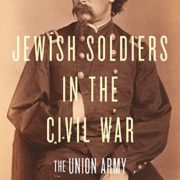Jewish Soldiers in the Civil War: the Union Army – by Adam D. Mendelsohn
By Sheldon Goldberg, PhD
Ten years ago, when I became a Docent and Historian at the National Museum of American Jewish Military History, I was honored to follow in the footsteps of those who had come before me. I gathered the materials they used, read the histories written about Jews in the military, and did research on the internet to update them, especially about the Jewish Medal of Honor recipients. I also found the museum’s exhibit books invaluable as I wrote my lectures and prepared scripts to memorize for tour groups. And so it went until the arrival of “Jewish Soldiers in the Civil War: The Union Army” by Adam Mendelsohn.
Mendelsohn’s book is the result of ten years of research sponsored by the Shapell Manuscript Foundation, using Simon Wolfe’s “The American Jew as Patriot, Soldier and Citizen,” from 1895, as a starting point. Wolfe claimed as many as 10,000 Jews served in the Civil War. “Jewish Soldiers in the Civil War” is an attempt to correctly identify every Jew who served in the Union Army, something Wolfe’s error-prone book attempted. While Mendelsohn’s book has been published, it is, in fact, unfinished. Shapell researchers continue to attempt to identify Jews who fought on both sides, delving into archives across the country, finding personal letters, photographs, memoirs, and of course, official documents, thus adding names on an almost daily basis. That said, it tells a story – one I had been telling, but which now requires some key changes.
“Jewish Soldiers in the Civil War” is presented in six chapters that describe where those identified Jews who served came from, what their occupations were, how and why they enlisted, many, but not all, just for the bonus, and for how long. It is important to note that not every Jew who served was an abolitionist. Many feared that freed slaves would take their jobs.
Mendelsohn writes that the dearth of Jewish compatriots, as opposed to some majority German or Irish regiments, led some to deny their faith, even to other Jews, or to change their names. Among those who served were brave heroes and cowardly deserters, upstanding members of society, and lowly crooks. He also points out that while antisemitism existed, Jewish soldiers often changed their units to avoid the slurs and attempts to proselytize them. That said, the exigencies of combat and the conditions under which all soldiers lived also created friendships between Jews and non-Jews, many of which lasted beyond the end of the war. Mendelsohn also clarifies the roles played by the Board of Delegates of American Israelites in Washington and Rabbi Arnold Fischel, by debunking the existing myth of how three Rabbis came to serve as Jewish Chaplains in the Union Army.
Lastly, although it is not made clear in the book, this project is a work in progress. Based on the research conducted when the book was published, there were only 1,235 Union soldiers positively identified as Jewish out of what is believed to be just over seven thousand. Of those identified are six generals, five of whom were breveted, i.e., temporarily promoted to a rank higher than what they normally held. One appendix shows that of those 1,235, only a few regiments had as many as twenty Jews while most had but one or two. Furthermore, the research has confirmed a fifth Jewish Medal of Honor recipient, Eugene P. Jacobson. That said, this is an outstanding work, easy to read, that sheds a whole new light on the Jewish contribution to the Civil War.
Volume 77. Number 1. 2023




